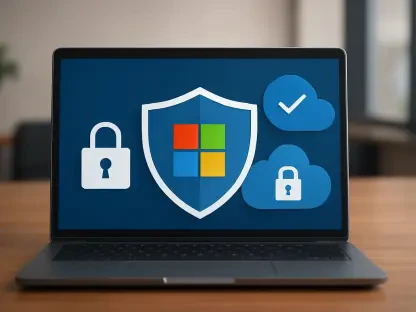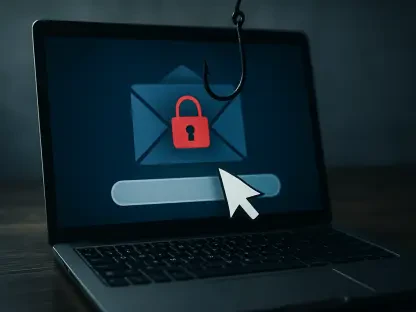In a world where compassion fuels action, what happens when cybercriminals turn humanity’s goodwill into a weapon against those who need it most? On October 8, 2025, a sinister phishing campaign emerged, targeting the very organizations striving to provide relief amid Ukraine’s ongoing conflict, revealing a chilling reality. Dubbed “PhantomCaptcha,” this attack has struck at the heart of humanitarian efforts, ensnaring entities like the International Red Cross and regional Ukrainian administrations in a web of deception. This sophisticated assault shows that even the noblest causes are not safe from the predatory reach of cybercrime.
The Urgency of a Hidden Danger
Amid the chaos of war, organizations like UNICEF and the Norwegian Refugee Council have become lifelines for countless Ukrainians. Yet, PhantomCaptcha’s emergence underscores a grim truth—cybercriminals are exploiting these turbulent times to target critical support systems. This campaign is not just a technical nuisance; it represents a calculated effort to destabilize humanitarian operations when they are needed most. The stakes are high, as stolen data or disrupted systems could mean the difference between aid reaching those in need or falling into the wrong hands.
The implications extend far beyond a single attack. Cybersecurity experts warn that such incidents are part of a growing trend, with attacks on humanitarian sectors increasing by 35% over the past year, according to recent studies. This statistic paints a stark picture of vulnerability, urging a collective focus on safeguarding the digital infrastructure that underpins global relief efforts. Understanding this threat is essential for anyone invested in protecting the integrity of aid during geopolitical crises.
Inside the Deceptive Web of PhantomCaptcha
PhantomCaptcha operates with a level of cunning that sets it apart from typical phishing scams. Attackers masquerade as the Ukrainian President’s Office, sending an eight-page PDF memo that appears legitimate at first glance. When opened, the document redirects unsuspecting victims to a counterfeit Zoom site hosted on infrastructure tied to a Russian provider, a detail uncovered by researchers from SentinelLabs and the Digital Security Lab of Ukraine. This initial deception is only the beginning of a multi-layered trap.
The campaign employs a tactic known as “ClickFix,” tricking users into executing a PowerShell command through a fake Cloudflare verification page. This user-initiated action cleverly bypasses standard security measures, paving the way for malware deployment in three distinct stages: a hidden downloader script, a data-collection module, and a WebSocket-based remote access Trojan for sustained control. Such precision reflects months of preparation—evidence suggests the adversary spent at least six months refining this operation before striking.
Beyond email-based attacks, a parallel threat targets mobile users with Android apps disguised as adult content or cloud storage services. One app, distributed through a suspicious domain, harvests sensitive information like contacts and location data. This multi-platform approach highlights the breadth of the adversary’s strategy, aiming to infiltrate through every possible digital entry point while rapidly dismantling visible infrastructure to evade detection.
Voices from the Frontlines of Cybersecurity
Experts are sounding the alarm on the meticulous nature of this cyber offensive. A SentinelLabs analyst described the operation as “a masterclass in compartmentalization, designed to strike hard and disappear fast.” This assessment points to a highly organized threat actor with a clear agenda, likely tied to broader geopolitical motives aimed at undermining Ukraine’s support networks. The short-lived attack windows—often just a day—demonstrate an intent to minimize exposure while maximizing damage.
Further analysis reveals alignment with emerging threats, such as AI-driven social engineering tactics projected to dominate cybercrime by 2026. Researchers note that the adversary’s ability to blend impersonation with technical sophistication mirrors these future risks, making PhantomCaptcha a precursor to even more dangerous campaigns. The consensus is clear: this is not a random act but a strategic move to exploit vulnerabilities in times of crisis, a tactic that could inspire similar attacks if left unchecked.
The Broader Impact on Humanitarian Efforts
The ripple effects of PhantomCaptcha extend deep into the fabric of humanitarian work. When organizations tasked with delivering aid are compromised, the consequences are not merely digital—lives hang in the balance. Stolen data could expose donor information or disrupt supply chains, while system downtime might delay critical resources like food and medical supplies. For Ukraine, already battered by conflict, such disruptions amplify an already dire situation.
This campaign also erodes trust, a currency as valuable as any aid package. When phishing emails mimic trusted authorities, recipients grow wary of legitimate communications, slowing down response times and sowing confusion. A case study from a regional Ukrainian administration revealed that staff hesitated to open urgent memos for days after the attack, fearing further deception. This psychological toll adds another layer of harm, one that cannot be easily quantified but is profoundly felt.
Building Defenses Against an Evolving Enemy
Combating a threat as intricate as PhantomCaptcha demands proactive and practical measures. Organizations must prioritize user education, emphasizing caution with emails that prompt actions like executing commands in Windows Run dialogs. A single moment of hesitation before clicking can prevent catastrophic breaches, and this mindset needs to be ingrained across all levels of staff, from executives to field workers.
Technical safeguards are equally critical. Monitoring PowerShell activity for anomalies and enforcing strict execution policies can block unauthorized scripts before they take root. Network administrators should also keep a close eye on WebSocket connections, especially those tied to newly registered or suspicious domains mimicking trusted entities. For mobile users, avoiding unverified apps—particularly those promising free content or storage—and employing robust antivirus tools are non-negotiable steps in staying safe.
Reflecting on this dark chapter in cyber warfare, it became evident that PhantomCaptcha exposed a critical vulnerability in the digital armor of humanitarian efforts. The audacity of targeting relief organizations during Ukraine’s struggle underscored the lengths to which adversaries will go to exploit compassion. Yet, this moment also sparked a renewed resolve among cybersecurity communities to fortify defenses. Moving forward, the focus must shift toward collaborative innovation—developing smarter detection tools and fostering global partnerships to outpace evolving threats. Only through such unified action can the digital lifelines of aid be secured, ensuring that goodwill prevails over malice in the face of future challenges.









